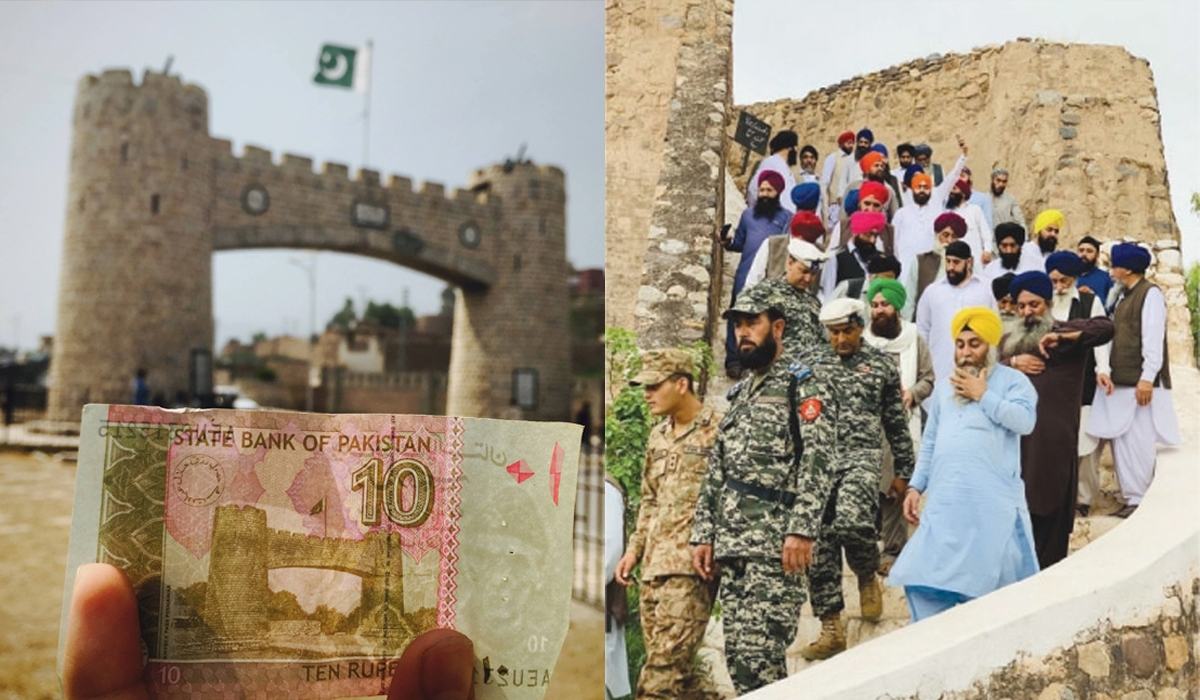When you study the history of famous Indian rulers, be it the Mughals, the Suri dynasties, the Greeks, Afghans or Turk warriors or the history of Indo-Afghan relationship and clashes, you will most probably hear about the importance of the centuries-old “Khyber Pass”.
This passage remained of a major strategic importance because it serveed as a trade route as well as a pathway for many conquerors and preachers who found their way from Afghanistan and Central Asia towards ancient India via The Khyber Pass.

Lying at the North-West frontiers of Pakistan, the Khyber Pass is a 53 kilometers stretched pathway between two historically important cities of the Pashtun population, Kabul (Afghanistan) and Peshawar (Pakistan). This historical road passes through the ‘Speen Ghar’ (or Safed Koh) mountain range (which means ‘White Mountain’) and goes all the way to the Nangarhar province of Afghanistan.
Pashtun tribes of “Afridi” & “Shinwari” reside near to Khyber Pass who are well known for their bravery, courage and valorous history because they gave lives in struggles against the occupations of Mughals, Sikhs and against the British Imperialism. The Khyber Pass keeps geographical, strategic and economic importance to the Pakistani state as well as to both the local Pashtun community of Pakistan and those who reside in Afghanistan.
The Khyber home to several monuments including ‘Shopla Stupa’, a Buddhist monument belonging to an ancient Buddhist civilization and “Ali Masjid” which is religiously important to local Muslims. The monuments are easily accessible not only from Peshawar via the Grand Trunk Road but also from the capital city of Islamabad using an easy route from M1 Motorway (Islamabad) to Peshawar Motorway.
Besides religous monuments, the area is also home to other numerous historical monuments which play a vital role in the cultural history of the area. Two monuments here that hold the most historical significance are the Bab-e-Khyber (The Gate of Khyber) and Jamrud Fort (aka Fatehgarh) that are situated in the Jamrud town of the Khyber tribal district of Khyber Pakhtunkhwa. (Khyber District was an agency of formerly known Federally Administrated Tribal Areas (FATA) that was eventually merged with the Khyber Pakhtunkhwa province in 2018). The first monument dates back to the ninteenth century while the later belongs to mid-twentieth century.
Ameer Hamza Khan Shinwari, a renowned Pashto poet who belonged to the town of Jamrud, quoted some verses regarding the mighty Khyber Pass while linking it to the heritage and identity of Pashtuns:
د خيبر دره خو لار د تلو راتلو ده
Translation:
په کابل او پيښور کي افغان یو دي
Khyber Pass is just a path for travelers
Afghans (Pashtuns) in Peshawar & Kabul are one
Is Bab-e-Khyber just a monument or does it really hold importance in the history of Khyber Pass?
Starting with name “Bab-e-Khyber”, ‘Bab’ is an Arabic word which means ‘gate’ hence it also portrays the strong ascendancy of Arabic language and Islamic values. The Bab-e-Khyber is an arch-styled monument built of bricks consisting of two column structures with canon guns lying over each of them that verily tributes the bravery of the circumscribed tribesmen near Khyber Pass.

It is a pylon placed on the historic path existing between Kabul and Peshawar of which proposition to the federal government of Pakistan was seconded by the then Chief Commissioner of Peshawar, Mr. G. A Madani and the Political Agent of Khyber Agency, Mr. Sarfaraz Khan, to mark the importance of Khyber Pass on national level. Later, the contract was granted to local builders who actually constructed the monument and was finally inaugurated in the month of June 1963.
Although it is one of Pakistan’s post-independence monument but it has an aesthetic connection with the local tribesmen, symbolizing their culture and heritage. The monument gained esteem among Pashtuns to an extent that they built structures similar to Bab-e-Khyber. Given the fact that the monument quickly procured as a symbol of identity for the Pashtun community, the Khyber Pakhtunkhwa government started using it in official emblems of the provincial government and former FATA’s administration. The monument also gained fame on national level as the State Bank of Pakistan printed its picture on Ten Rupees banknotes.
It might be just a gate to foreigners but for the locals, the Bab-e-Khyber holds a significant importance in their hearts.
Jamrud Fort remained strategically important
The second most famous monument of Khyber district and Jamrud Town is the “Jamrud Fort” which lies beside the iconic monument of Bab-e-Khyber. The Jamrud Fort was built by Sikh Khalsa army’s General Hari Singh Nalwa after he expanded frontiers of the Sikh Confederacy led by Maharajah Ranjeet Singh towards Peshawar and Jamrud in 1836 for a very short period.

Hari Singh (who was appointed as governor of Sikh Empire in Hazara, Kashmir and Peshawar) started building this fort in the December of 1836. It took a total of fifty days to build and was finally completed in 1837. The fort was built as commemorating symbol of victory by Punjabi Jutt clan’s Sikhs over fragmented tribes of Afridi and Shinwari Pashtuns and was titled “Fatehgarh”. The fort proved to be his last resort as the General breathed his last in here.
The idea behind building this fort by General Hari Singh Nalwa was inspired by making of strategic outposts in order to capture the adjacent Tirah Valley and Landi Kotal, a town in the Khyber District near Pak-Afghan border; and to move forward towards more Afghan regions of Nangarhar and Kabul in the future.

In 1838, Emirate of Afghanistan’s famous General Wazir Dost Mohammad Akbar Khan stepped forward to liberate Jamrud. He aligned with local tribesmen of the region and fought a fierce battle against the Khalsa army, known as the “Battle of Jamrud”. The local tribes alliance and Afghan Army were led by Dost Muhammad Akbar Khan while the Sikh Khalsa Army was under the command of General Hari Singh Nalwa.
General Hari Singh was killed in this battle, control of Jamrud Town fell in to the hands of the local tribesmen and the Jamrud Fort was kept under control of Afridi tribal leaders whom were having heavy influence from monarchs of Afghanistan at that time. Hari Singh Nalwa’s body was cremated according to traditions of Sikhism and his ashes were buried in a hall situated in the outer section of the fortress.

Later on, the Jamrud fort was used as a defensive post by pro-Afghan Kingdom tribesmen against the imperialist push of British India towards Afghanistan. It fell under control of British nearly in the times before the “Treaty of Gandamak” was signed between the Afghan Kingdom and British Empire in 1879 which eventually led to the signing of “Durand Line Agreement” in 1901 at Rawalpindi.
After the independence of Pakistan, control of Jamrud Fort fell to Pakistani Armed Forces and was later transferred to XI Corps of Pakistan Army (Peshawar Corps) which were established in 1975 due to possible military threat of Communist Afghan government and USSR’s Red Army at that time.
In 2018, a delegation of Sikh pilgrims led by Babaji Sardar Gopal Singh were granted permission by Pakistani government to visit and perform rituals in the places that were used for the purpose of residence of Hari Singh Nalwa and in the places where he used to perform his religious rituals (a historic and small Gurdwara is also present inside Jamrud Fort). It was the first ever Sikh delegation whom were allowed to visit the area under full-fledge security of Pakistan Army and Frontier Corp KP ever since it was lost by Hari Singh to Pashtun tribesmen after their glorious victory over the Sikh Khalsa Army.
Both the monuments are iconic parts of our history and can prove a great tourist attraction for foreigners as well as the locals. The current Pakistani government claiming to take steps for the complete implementation of KP-FATA merger should also sustain recreation sites near to thsese historic monuments and convert Jamrud Fort from a Garrison into a Museum which is accessible to public.
Such initiatives will pave the way towards preserving heritage of not just the local communities but also Afghanistan and the South Asia.
The people of Khyber District who were always intentionally or unintentionally neglected by the authorities, will also get numerous benefits if proper tourism setup has been established with true cooperation of public and private sectors.


